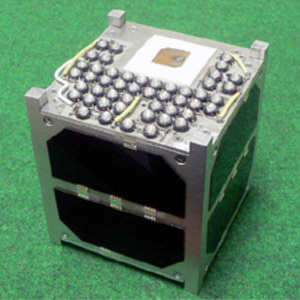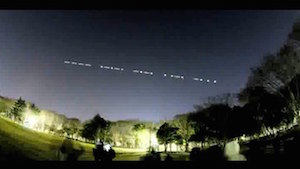Difference between revisions of "FitSat-1"
Jump to navigation
Jump to search
Smaldonado (talk | contribs) (Added to Optical Communications category) |
Smaldonado (talk | contribs) (Moved image to right side) |
||
| (One intermediate revision by one other user not shown) | |||
| Line 1: | Line 1: | ||
| + | [[File:FITSAT-1.jpg|frame|right|FitSat-1, built by the Fukuoka Institute of Technology, featured a full wall of LEDs]] | ||
| + | [[File:FITSAT-1_trace.jpg|frame|right|The morse code transmissions were visible with long-exposure photography]] | ||
| + | |||
FITSAT-1 was a small satellite launched on October 4, 2012 by the Japan Aerospace Exploration Agency (JAXA). It included green power LED’s and an experimental video transmitter. The LED’s were visible from the ground using standard photographic equipment, transmitting morse code decodable in long-exposure photography. This is an exciting mission profile that engages the public in the space industry. Since the launch of this spacecraft, LED’s that produce 30% to 40% more light for the same power have reached the market, making a repeat or improvement on this mission highly achievable. | FITSAT-1 was a small satellite launched on October 4, 2012 by the Japan Aerospace Exploration Agency (JAXA). It included green power LED’s and an experimental video transmitter. The LED’s were visible from the ground using standard photographic equipment, transmitting morse code decodable in long-exposure photography. This is an exciting mission profile that engages the public in the space industry. Since the launch of this spacecraft, LED’s that produce 30% to 40% more light for the same power have reached the market, making a repeat or improvement on this mission highly achievable. | ||
Latest revision as of 21:45, 4 December 2015
FITSAT-1 was a small satellite launched on October 4, 2012 by the Japan Aerospace Exploration Agency (JAXA). It included green power LED’s and an experimental video transmitter. The LED’s were visible from the ground using standard photographic equipment, transmitting morse code decodable in long-exposure photography. This is an exciting mission profile that engages the public in the space industry. Since the launch of this spacecraft, LED’s that produce 30% to 40% more light for the same power have reached the market, making a repeat or improvement on this mission highly achievable.
A complete description can be found on the FitSat-1 website [1].

